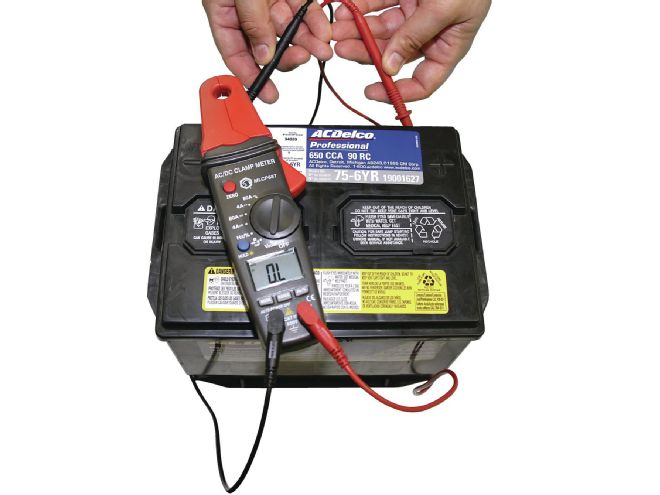
One of the most frustrating issues for any Pontiac owner is an electrical problem, especially one that drains the battery. You didn't leave the headlights on or the door open, so why is the Pontiac stone dead? Thinking it is just a fluke, you charge the battery or jump start the engine, and all seems good, but overnight it is dead again.
In the parlance of automotive repair, this condition is identified as a parasitic drain. In lay terms, it describes a circuit that is powered even though the ignition is off. It can be a frustrating and often confounding issue, since you really do not know where to look for the cause.
The basis of any electrical-circuit diagnosis is accurate information. Every person who has ever tried to diagnose an electrical problem has experienced the frustrated feeling of staring at a circuit and not being able to see what is wrong.
Electricity cannot be seen as it flows through a wire. So in order to diagnose a problem, it is necessary to see the manner in which the circuit reacts to electrical flow. Whenever electrical systems are being diagnosed, you need accurate instruments and wiring diagrams. These aids will allow you to look inside the circuit so you can interpret its function.
The Matco Parasitic Drain Tester
Professional-tool supplier Matco Tools is constantly looking for ways to make automotive repair easier, quicker, and more accurate, all while being less invasive. This is especially true when dealing with a parasitic drain or most other electrical issues. The task can be likened to trying to find a water leak in a house. Have you ever made a hole in the wall or ceiling only to find that the problem is not in that location? The same often occurs when working on electrical issues. You remove your Pontiac's interior (or some other part) only to find the issue is not there. Then, due to the nature of cars, the area doesn't go back together the same way since the parts are old and brittle.
HPP was very interested in the new Matco Parasitic Drain Tester (PN TH209). With it, a user can unobtrusively check each circuit in the vehicle without even removing the fuse to quickly determine the open circuit or circuits. (Matco's don't-remove-the-fuse feature is of great value since classic Pontiacs employ a Buss-type glass fuse that is often hard to remove without cracking the glass. Later Pontiacs employed a bayonet-style fuse; it too was fitted very tightly for reliable service.)
Before we explore the virtues of the Matco parasitic drain tester, let's review traditional electrical-diagnostic steps that can be used on any Pontiac and contrast them with the new technology of the Matco tester. We don't want to falsely represent that an electrical draw cannot be diagnosed without the Matco tool—the tool just makes it faster and easier. There are other electrical issues that can happen in a Pontiac that still require the use of a basic ohmmeter or voltmeter, and these will be briefly reviewed. In HPP tradition, a complete representation will be presented.
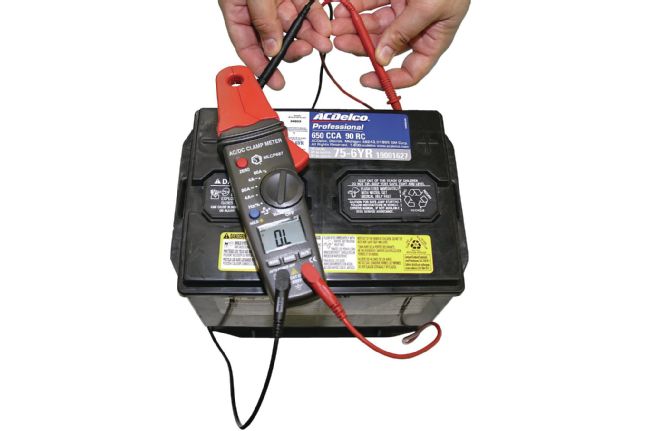 When your Pontiac has a parasitic drain, it can leave your battery so dead that its voltage won’t register on a multimeter.
When your Pontiac has a parasitic drain, it can leave your battery so dead that its voltage won’t register on a multimeter.
Volts/Ohms/Amps
The most practical meter for any enthusiast is a multimeter. This tool combines a voltmeter, ammeter, and ohmmeter in one unit, either analog or digital. The one disadvantage of a multimeter is that the measured current draw is usually limited to 10-20 amps. Therefore it is good for almost every electrical circuit in an older Pontiac except the starter.
An ohmmeter measures resistance and can only be used on an unpowered circuit. It has no polarity, so it doesn't make any difference which lead is connected to either end of the circuit. The only time this doesn't apply is when checking a diode. For example, if you want to check the amperage draw of an electric antenna, the circuit must be disconnected and the meter installed in series, the ignition turned on, and the antenna activated to obtain a reading. If the resistance of the power-antenna motor was to be checked, the component must be unplugged and an ohmmeter lead attached to each wire in the plug of the motor.
An ammeter measures the load that is being consumed or used by the circuit. It is polarity sensitive. To obtain a reading, the circuit must be connected and in operation. A traditional ammeter needs to be connected in series with the circuit. That describes the circuit being broken and the meter installed as part of the current path. Some more expensive meters (such as Matco PN MLCP687) use an inductive clamp that is just clipped around the wire and does not need to have the meter become part of the circuit. This design reads the magnetic field that is created around the wire from the electron flow.
A voltmeter is connected in parallel; the circuit remains intact and isn't invaded to obtain a reading. Like the ammeter, it requires proper polarity when being connected to the test point. For example, if you want to check the voltage of your Pontiac's 12V battery, you attach the meter leads to the proper terminal without disrupting the connections at the battery.
Since each meter is slightly different in operation, you should read the owner's manual and become very familiar with the scales, settings, and connections before attempting any diagnostic procedure. Nothing is worse than trying to diagnosis an electrical problem as you try to figure out the test instrument.
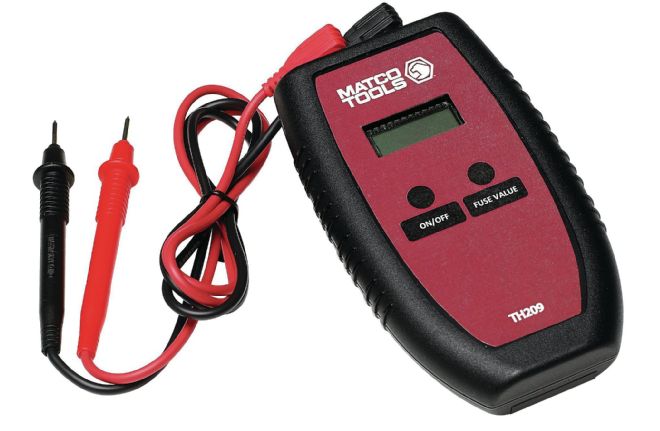
1. The Matco parasitic drain tester makes troubleshooting electrical problems easy. It’s available directly from Matco for $199.
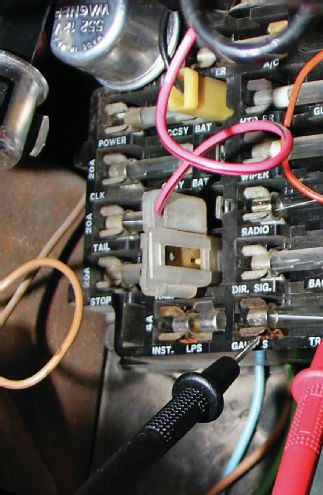
2. When testing for a parasitic draw, the fuse box needs to be accessed. The Matco parasitic drain tester is 100-percent compatible with classic Pontiac fuseboxes that employ Buss-type glass fuses, like those shown here.
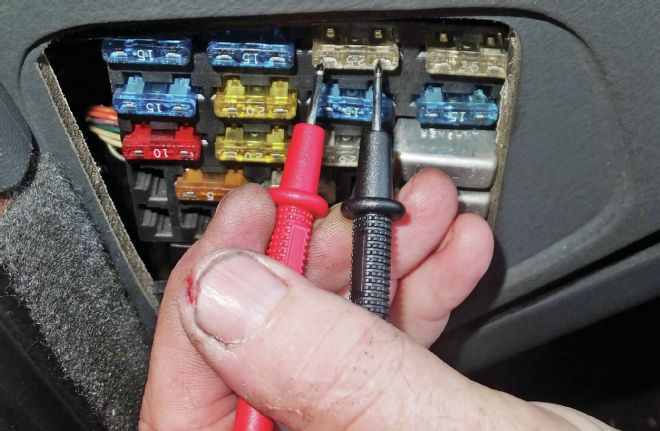
3. Some late-model Pontiacs have two fuse boxes—one on the side of the dash, like the Firehawk shown here, or in the glovebox…
Something Old, Something New
Now let's look at some traditional procedures for testing parasitic drain:
1. Checking for a draw with the ignition off
Tool: Test light or multimeter set on amperes
Problem: The battery goes dead when your Pontiac is not started or driven for a while.
The first nice day of spring is here and you want to go for a ride. But as you open the door of your Pontiac, a dark dome light and a dead battery greet you. After charging the battery, you use a simple test light and discover a draw. To recap, that means a circuit is not shutting off. Remove the battery ground cable and install a test light in series to the ground path. If the light illuminates, there is a draw. Now start removing fuses from the fusebox until the light goes off. When it shuts off, you found the circuit that is staying powered on with the ignition off.
(On newer Pontiacs, it's better to use an ammeter connected in the same manner to identify the amount of the draw. A modern electronic radio with station memory or a clock will illuminate the test light since they draw current with the ignition off. Not to worry—these circuits use so little energy, it would be hard for them to kill a battery even after months of vehicle storage.)
2. Checking alternator output Tool: Multimeter set on volts
Tool: Multimeter set on volts
Possible use: Confirming charging circuit output
With the engine off, connect the voltmeter leads to the battery's positive and negative terminals. The reading should be a minimum of 12.6 volts and can be as much as 2 volts higher due to the accumulation of what is called a surface charge. Now start the engine and check the battery voltage. The reading should be higher than with the engine off. Next race the engine and have a helper turn on electrical loads such as the headlights, wipers, heater, and A/C. With the engine at approximately 2,000 rpm, the battery voltage should be at or near the reading at idle with no electrical load. If not, then the charging circuit isn't working at its full potential and may have voltage regulator or alternator issues.
3. Check battery cranking voltage
Tool: Multimeter set on volts
Possible use: Determine if the battery has enough voltage to crank the engine
With the voltmeter attached to the battery, have a helper crank the engine over. You may want to disable the ignition coil so you can extended the cranking period. With a fully charged battery, the voltage should stay above 9.6 during crank. If the voltage drops below that, it's possible the battery is weak or the starter is drawing an excessive amount of current. If the voltage stays high and the engine turns slowly, there is a problem with the starter circuit, such as a poor ground, but the battery is fine.
4. Checking a diode
Tool: Multimeter set on ohms
Possible use: Confirmation of an inoperable component that employs a diode
Diodes are used in alternators and many early air-conditioner systems. The diode was usually placed across the compressor-clutch circuit to avoid a voltage spike back into the charging circuit when the clutch shuts off. If the diode is open, the circuit will not work.
Gain access to the diode. A good diode will only pass current one way. This will mean the ohmmeter should read little or no resistance with the leads connected one way and infinity with them connected in reverse. Anything else and the diode is defective and needs to be replaced.
Using the Matco Parasitic Drain Tester for Parasitic Draw
The Matco parasitic drain tester has the unique ability to shunt or electrically remove the fuse from the circuit without physically removing it from the fusebox. This is accomplished by the advanced circuitry in the $199 American-made tester and your programming for the capacity of the fuse circuit being tested. For example, if the circuit being explored has a 20-amp fuse, you should calibrate the tester to tell it that. TH209 has the ability to withstand a draw of up to 80 amps, which is between four and eight times that of even the most expensive multimeter.
Once set properly for the fuse value, the next step is simple. Just use the two leads to make contact with the fuse and read the amount of current (amps) being drawn by that circuit. Go from fuse to fuse until you find the circuit that is being powered and killing the battery with the ignition off.
Next, look in the wiring diagram for your Pontiac to determine what component(s) that circuit powers. You may discover that a particular fuse powers the underhood, glovebox, and trunk lights. Remove one of the bulbs and test again to see if the draw is still present. For example, if you first remove the glovebox lightbulb and the draw on the TH209 tester is still the same, put that bulb back—the problem is not there. Now go to the trunk and remove that bulb; when you look at the TH209 tester, the draw is gone. You have quickly and easily learned that the trunk-light switch is faulty and keeps the bulb on, thereby killing the battery.
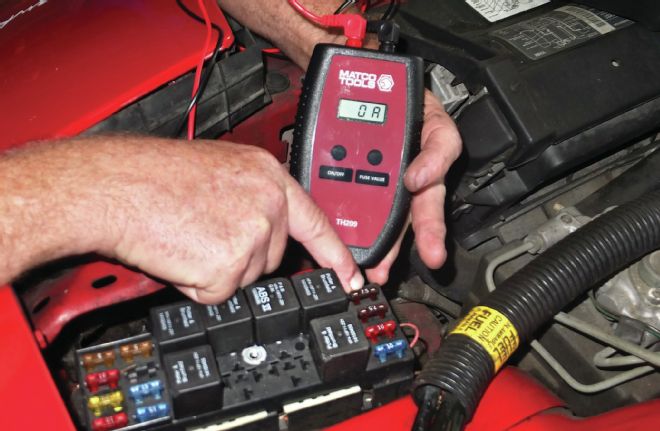
4 … and another under the hood.
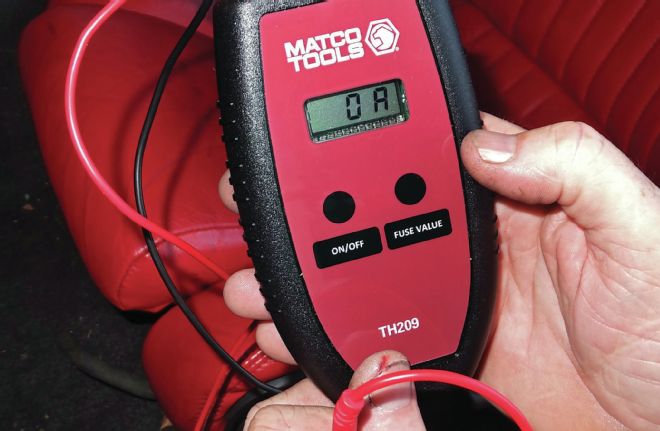
5. If after setting the correct amperage rating, the instrument’s LCD screen reads 0A (amps), the circuit does not have a draw.
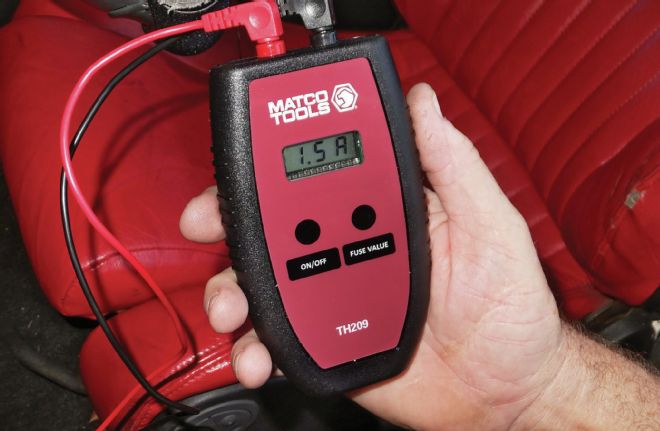
6. With the ignition turned off, however, another circuit reads 1.5 amps, which explains why this Bird’s battery kept going bad after several weeks of vehicle storage.
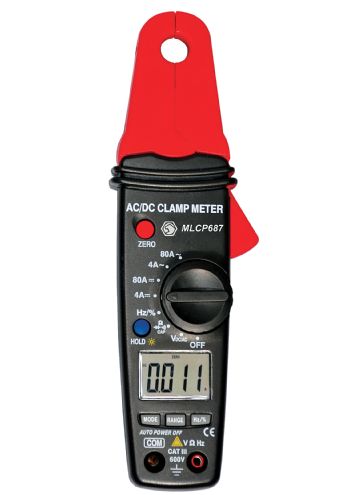
7. Now it is time to call out the Matco low-current probe/digital clamp multimeter (PN MLCP687). It’s available directly from Matco for $207.
The Matco Low-Current Probe/Digital Clamp Multimeter
Let's be clear—the Matco parasitic drain tester identifies which fused circuit is staying powered, but it does not tell you anything more. You need to explore, disconnecting each component in that circuit until the draw stops—unless you have the Matco Low Current Probe/Digital Clamp Multimeter (PN MLCP687), which retails for slightly more than $200.
Doubling as a low-current voltage probe and traditional multimeter, complete with positive and negative wire leads, MLCP687 contains an inductive clamp that allows you to test various wires within a respective circuit to determine the accessory or component responsible for the current draw. When testing circuits on your Pontiac, don't be alarmed if you see minute voltage draws from various wires. Anything greater than 30 milliamps can, however, run down your Pontiac's battery over time.
When diagnosing an electrical problem, the more time spent thinking and analyzing the circuit, the less the Pontiac will be violated and the quicker the repair can be done. The proper procedure for detecting a faulty component should include individually disconnecting various accessories and/or removing light bulbs, while monitoring the meter's digital display. As soon as the numeric readout decreases, you've accurately located the suspect component and the appropriate repair can be performed.
The most common parasitic-drain culprit?
Don't forget, in many instances a parasitic drain can be caused by a bad diode in the alternator. When the ignition is off, it back-feeds to ground. In this case, you would simply electrically disconnect the alternator and check for a draw at the battery. In most if not all Pontiacs, the fuse box would not be the place to test, but a meter or test light in series with the negative battery terminal and cable would be the location.
Using the proper terms
Quite often, both the enthusiast and professional mechanic alike use the wrong terms when describing an electrical problem. They confuse a short circuit with an unintentional ground. Let me explain.
By General Motors' definition, a short is two circuits that touch. It is known as copper-to-copper. For example, you blow the horn and the dome light comes on. This is a short circuit. A short circuit can cause a parasitic drain if the one circuit is powered independently of the ignition switch. Let us say that a wire directly from the battery rubs against the feed wire for the cigar lighter, then the lighter would stay on all the time and kill the battery.
In contrast, a circuit that blows a fuse is an unintentional ground or, as some would like to call it, a short to ground. This bypasses the controlled load, and can be likened to taking a wire from the battery positive and putting it to ground. So if your Pontiac blows the taillight fuse every time you step on the brake pedal, then the voltage is not going to the bulb, but instead right to ground. The load in the circuit is the resistance to current flow—a sheetmetal screw through a wire is a direct path to ground, and the circuit will flow the full battery amperage potential until either the fuse or the wire burns up.
It is important to recognize this. When looking for an unintentional ground, you disconnect the Pontiac's battery; then, using the ohmmeter, you have one lead on the circuit being tested and the other to a ground. If there is continuity, then that circuit is grounded and is the problem.
When trying to find a short, the two circuits need to be identified. If there are any connections/plugs in the circuit, they should be systematically disconnected to close in on the area of the copper-to-copper contact. For example, if a certain fuse is blowing and the wiring harness goes into the car door and has a plug, open the circuit there and retest. If the fuse still blows, then you know that it it's not in the door, so there is no need to remove the door panel. —Ray T. Bohacz
Conclusion
At HPP, we were impressed by the functionality and versatility of both Matco tools and their prices. While either can be used independently, they simply work better as a team. TH209 allows you to quickly and easily determine the offending fused circuit, and MCLP687 allows you to isolate the accessory and/or component. At a couple hundred dollars each, they may seem like a lofty frill, but considering a typical automotive 12V battery can cost $100 or more, and being left discharged for any length of time can compromise its ability to recharge, Matco's latest offerings could be an investment in maximizing the reliability of your prized Pontiac.
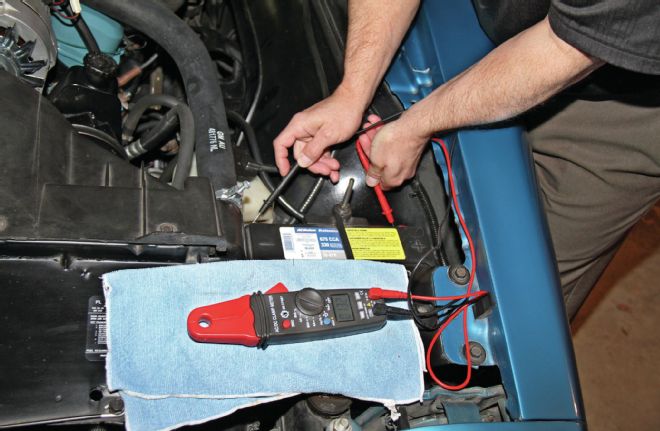
8. It has positive and negative leads to test for amps, volts, or ohms, like we describe in this story.
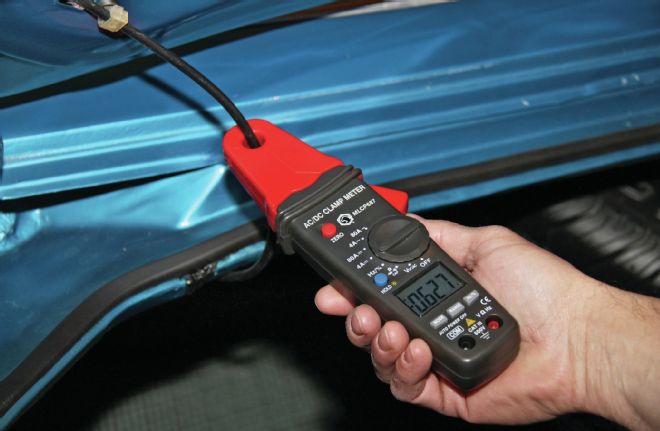
9. Testing for an electrical draw on wires, like the trunk light on this Second-Gen Firebird, is as easy as clamping the instrument’s jaws around the wire. The device used inductive-field technology to accurately measure the draw, if any.
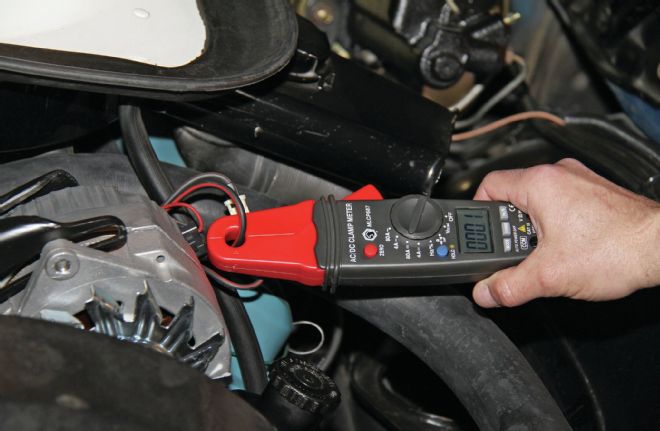
10. The clamp is useful wherever you can access an electrical wire on your Pontiac, like the alternator leads shown here.